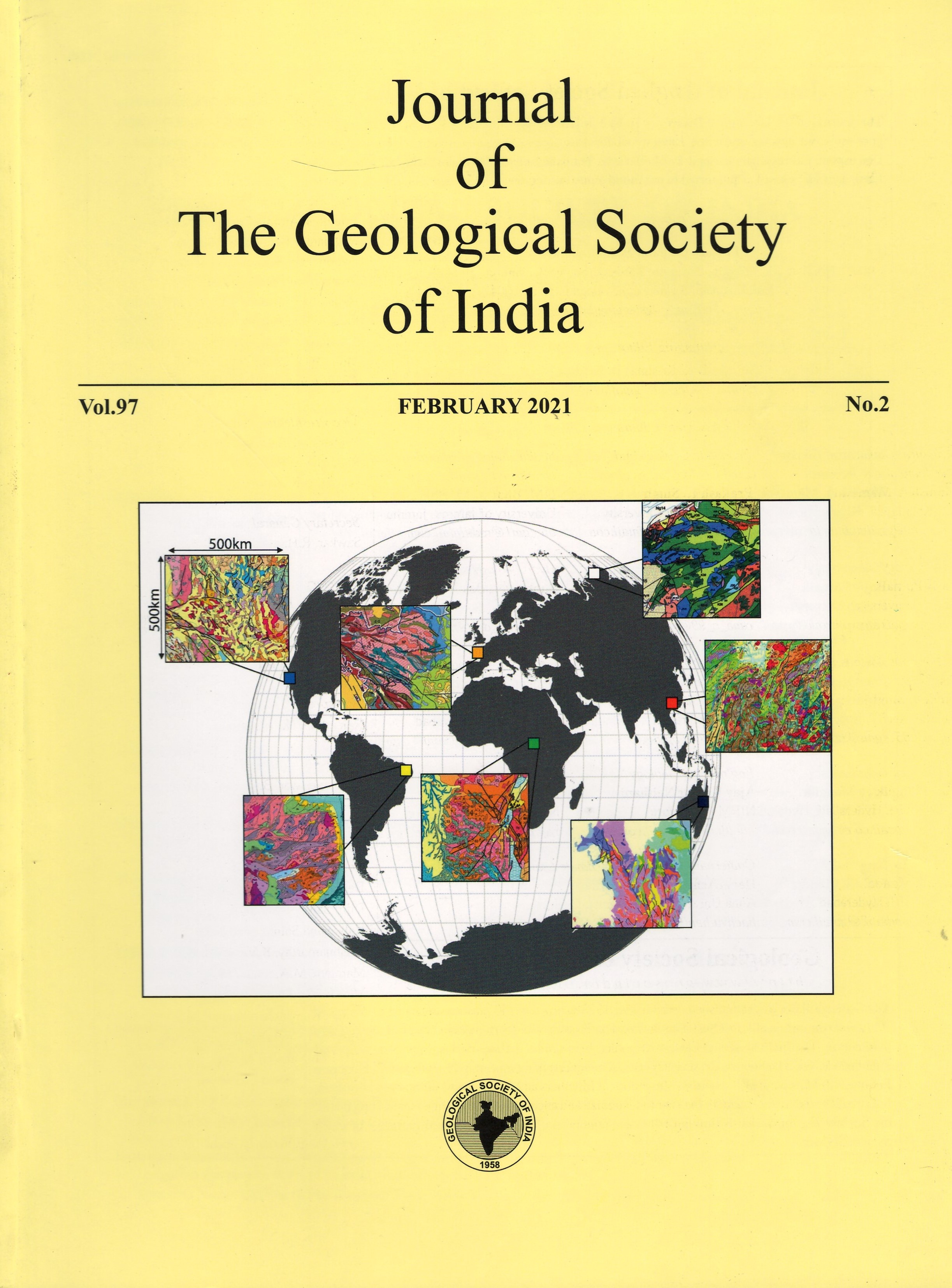Slope Stability Analysis Based on Rock Mass Rating, Geological Strength Index and Kinematic Analysis in Vindhyan Rock Formation
DOI:
https://doi.org/10.1007/s12594-021-1645-yKeywords:
No Keywords.Abstract
The Rock Mass Rating (RMR), Geological Strength Index (GSI) and kinematic analysis are widely employed in geotechnical engineering practice. The RMR and GSI both are used for rock mass characterization while the kinematic analysis is applied to identify the mode of failure of slope based on rock discontinuities and slope face characteristics of rock.
An attempt has been made to analyze the RMR, GSI and Kinematic Analysis using in-situ data corresponding to Vindhyan sandstone. The data has been collected from outcrops at seven different locations in and around Markundi hill along SH-5, Chopan, Sonbhadra. The relationship between RMR and GSI for Vindhyan sandstone in the study area has been attempted using generalize equation proposed by Hoek (2013) while the kinematic analysis has been applied to decipher the weak zone of failure using RocScience Dips software.
The lowest RMR value estimated is 35 for location S-4 and the highest RMR value is 58 for location S-1. Other locations viz, S-2, S-3, S-5, S-6 and S-7 have the RMR value from 42 to 49 which infers that the Vindhyan sandstone existing at Markundi is characterized by both poor as well as fair rock mass.
The GSI value of the location S-1 is estimated as 34 (minimum) and 46 (maximum) of location S-4. GSI value of the same rock formation also corroborates that the rock mass belongs to poor as well as fair rock mass.
The wedge failure is inferred due to intersection of two sets of joints oriented in north-west and north-east direction. The line of intersections of these two discontinuities are observed in wedge shaped block. It is concluded that the locations under investigations have tendency of wedge failure.
Downloads
Metrics
Issue
Section
Downloads
Published
How to Cite
References
Anbalagan, R, Singh, B, Chakraborthy, D and Kohli, A (2007) A Field Manual for Landslide Investigations. A Publication of Department of Science and Technology, Government of India, pp.1-153.
Bartarya, S.K. and Valdiya, K.S. (1998) Landslides and Erosion in the Catchment of the Gaula River, Kumaun Lesser Himalaya, India. Mount. Res. Dev., v.9(4), pp.405- 419.
Bieniawski, Z.T. (1974) Geomechanics classification in rock masses and its Application in tunneling. In: Advances in Rock Mechanics, Washington, D.C., National Academy of Sciences, v.2, part A, pp.27-32.
Bieniawski, Z.T. (1976) Rock mass classification in rock engineering. In: Z.T. Bieniawski (Ed.), Exploration for rock engineering. Proc. Symp., Cape Town, Balkema, pp.97-106.
Bieniawski, Z.T. (1979) The Geomechanics classification in rock engineering applications. In: Proceedings of the 4th Congress of the International Society of Rock Mechanics, Montreux, Switzerland. Rotterdam: A.A. Balkema, v.2, pp.41–8.
Hoek, E. and Brown, E.T. (1980) Empirical strength criterion for rock masses. Jour. Geotech Engg. Div., ASCE, v.106 (GT 9), pp.1013-1035.
Hoek, E. and Bray, J.W. (1981) Rock Slope Engineering. Revised 3rd Edition, The Institution of Mining and Metallurgy, London, pp.341-351.
Hoek, E. and Brown, E.T. (1997) Practical estimates of rock mass strength. Int. J. Rock Mech. &Mining Sci. & Geomechanics Abstracts, v.34(8), pp.1165-1186.
Hoek, E. (2007) Practical Rock Engineering. Toronto; Roscience. Hoek, E., Carter, T.G. and Dietrichs, M.S. (2013) Quantification of the geological strength index chart. In: Proc 47th US Rock Mechanics/ Geomechanics Symposium. San Francisco, ARMA CA, USA, pp.13–672. IS: 9143-1979. Method for determination of unconfined compressive strength of rock materials (BIS). IS: 13365-1997. Quantitative Classification System of Rock Mass-Guidelines, Part-3, Determination of Slope Mass Rating. Bureau of India Standards, New Delhi.
ISRM (1978) Suggested methods for quantitative description of discontinuities of rock mass. Internat. Jour. Rock Mech. Min. Sci., v.15, pp.319-368. Kahlon, S., Chandel, V.B.S., and Brar, K.K. (2014) Landslides in Himalayan mountains: a study of Himachal Pradesh, India. Internat. Jour. Engg. Appld. Sci. Res., (IJIEASR) v.3(9), pp.28-34. Kliche, C.A. (1999) Rock Slope Stability. SME, Littleton, CO. Kumar, S., Pandey, H.K., Singh, P.K. and Venkatesh, K. (2019) Demarcation of probable failure zones based on SMR and kinematic analysis. Geomatics, Natural Hazards and Risk, v.10(1), pp.1793-1804, Marinos, P. and Hoek, E. (2001) Estimating the geotechnical properties of heterogeneous rock masses such as Flysch. Bull. Eng. Geol. Environ., v.60, pp.85–92. Marinos, V., Marinos, P. and Hoek, E. (2005) The geological strength index: applications and limitations. Bull. Engg. Geol. Environ., v.6, pp.55–65. Marinos, P., Hoek, E. and Marinos, V. (2006) Variability of the engineering properties of rock masses quantified by the geological strength index: the case of ophiolites with special emphasis on tunneling. Bull. Engg. Geol. Environ., v65, pp.129–142. Palmstrom, A. (1974) Characterization of jointing density and the quality of rock masses (in Norwegian). Internal report, A.B. Berdal, Norway, pp.26. Roghanchi, P., Kallu, R. and Thareja, R. (2013) A new expression of three adjustment factors of slope mass rating (SMR) classification. International Jour.Earth Sci. Engg., pp-1-9. Starkel, L. (1972) The role of catastrophic rainfall in the shaping of the relief of the Lower Himalaya (Darjeeling Hills). Geographia Polonica, v.21, pp.103-160. Umrao, R.K., Singh, R., Ahmad, M. and Singh, T. N. (2011), Stability Analysis of Cut Slopes Using Continuous Slope Mass Rating and Kinematic Analysis in Rudraprayag District, Uttarakhand. Transport Res. Records - 1, pp.79-87. Vasarhelyi, B. (2016) Determining the Geological Strength Index (GSI) using different methods. Rock Mechanics and Rock Engineering: From the Past to the Future – Ulusay et al. (Eds). Virdi, N.S., Sah, M.P. and Bartarya, S.K. (2015) Project Report: Landslide Hazard Zonation in the Beas and Satluj Valleys of Himachal Pradesh, Phase-I Satluj Valley. Wadia Institute of Himalayan Geology, Technical Report, pp.132. Yoon, W.S., Jeong, U.J. and Kim, J.H. (2002) Kinematic analysis for sliding failure of multi-faced rock slopes. Engg. Geol., v.67, pp.51–61. Zhang, L. (2015) Determination and applications of rock quality designation (RQD). Jour. Rock Mech. Geotech. Engg., pp.5.

 Saurabh Kumar
Saurabh Kumar






